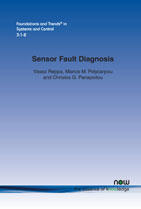Sensor Fault Diagnosis
By Vasso Reppa, University Paris-Saclay, France, reppavasso@gmail.com | Marios M. Polycarpou, University of Cyprus, Cyprus, mpolycar@ucy.ac.cy | Christos G. Panayiotou, University of Cyprus, Cyprus, christosp@ucy.ac.cy
Abstract
This tutorial investigates the problem of the occurrence of multiple faults in the sensors used to monitor and control a network of cyberphysical systems. The goal is to formulate a general methodology, which will be used for designing sensor fault diagnosis schemes with emphasis on the isolation of multiple sensor faults, and for analyzing the performance of these schemes with respect to the design parameters and system characteristics. The backbone of the proposed methodology is the design of several monitoring and aggregation cyber agents (modules) with specific properties and tasks. The monitoring agents check the healthy operation of sets of sensors and infer the occurrence of faults in these sensor sets based on structured robustness and sensitivity properties. These properties are obtained by deriving analytical redundancy relations of observer-based residuals sensitive to specific subsets of sensor faults, and adaptive thresholds that bound the residuals under healthy conditions, assuming bounded modeling uncertainty and measurement noise. The aggregation agents are employed to collect and process the decisions of the agents, while they apply diagnostic reasoning to isolate combinations of sensor faults that have possibly occurred. The design and performance analysis methodology is presented in the context of three different architectures: for cyber-physical systems that consist of a set of interconnected systems, a distributed architecture and a decentralized architecture, and for cyber-physical systems that are treated as monolithic, a centralized architecture. For all three architectures, the decomposition of the sensor set into subsets of sensors plays a key role in their ability to isolate multiple sensor faults. A discussion of the challenges and benefits of the three architectures is provided, based on the system scale, the type of system nonlinearities, the number of sensors and the communication needs. Lastly, this tutorial concludes with a discussion of open problems in fault diagnosis.
Sensor Fault Diagnosis
Recent advances in information and communication technologies, embedded systems and sensor networks have generated significant research activity in the development of so-called cyber-physical systems. An example of a large network of cyber-physical systems is a smart city with intelligent infrastructures for supporting the environment, energy and water distribution, transportation, telecommunication, health care, home automation, and so on. From a systems point of view, safety, reliability and fault tolerance become key challenges in designing cyber-physical systems.
One of the major issues is detecting and correcting faults in the sensors that form a critical part of these networks and systems. For example, if two sensors should provide similar information, how do you know which one is at fault should their readings suddenly greatly differ? Sensor Fault Diagnosis all the issues in sensor fault detection and isolation. It provides a clear tutorial on the challenges and models that can be used to address them. It describes, in detail, the requirements for modeling the systems, designing the architecture, detecting faults, isolating those faults, and presents learning techniques for enhancing performance. This monograph will appeal to all researchers and students working on large sensor networks and systems.
